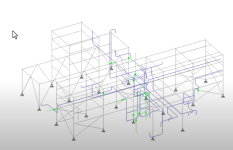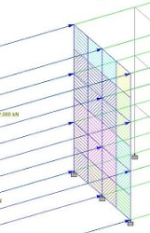OffshoreWindStructures
Structural
- Apr 29, 2023
- 32
Wind force coefficients for flat sided individual members are dependent on their slenderness (and thus their length as seen in design codes like British standards, Eurocodes , DNV , etc). It's easy to incorporate that for single member and there's guidelines for doing so with a regular lattice frame. It's more awkward to assign individual wind force coefficient values by hand (based on length, orientation and height from ground) to every single member when the number of members increases significantly. That approach really requires using software with such a capacity.
My question is what is your approach for assigning wind force coefficients for flat sided members in a non regular non lattice unclad open frame with a significant amount of members, either in hand calcs or FEA models.
Do you just take the conservative infinite length value (ignoring end effects reductions due to length) of approx 2.0 ?
Do you try to rationalize an average length of all members in your structure?
Do you assume a unit length of 1.0 m (as with other loads/resistances etc) ?
Do you treat the non regular frame as regular enough for your purposes and use the lattice frame overall coefficient based on solidity ?
or have an approach not mentioned?
Example structure could be similar to the following image (not mine)
My question is what is your approach for assigning wind force coefficients for flat sided members in a non regular non lattice unclad open frame with a significant amount of members, either in hand calcs or FEA models.
Do you just take the conservative infinite length value (ignoring end effects reductions due to length) of approx 2.0 ?
Do you try to rationalize an average length of all members in your structure?
Do you assume a unit length of 1.0 m (as with other loads/resistances etc) ?
Do you treat the non regular frame as regular enough for your purposes and use the lattice frame overall coefficient based on solidity ?
or have an approach not mentioned?
Example structure could be similar to the following image (not mine)


